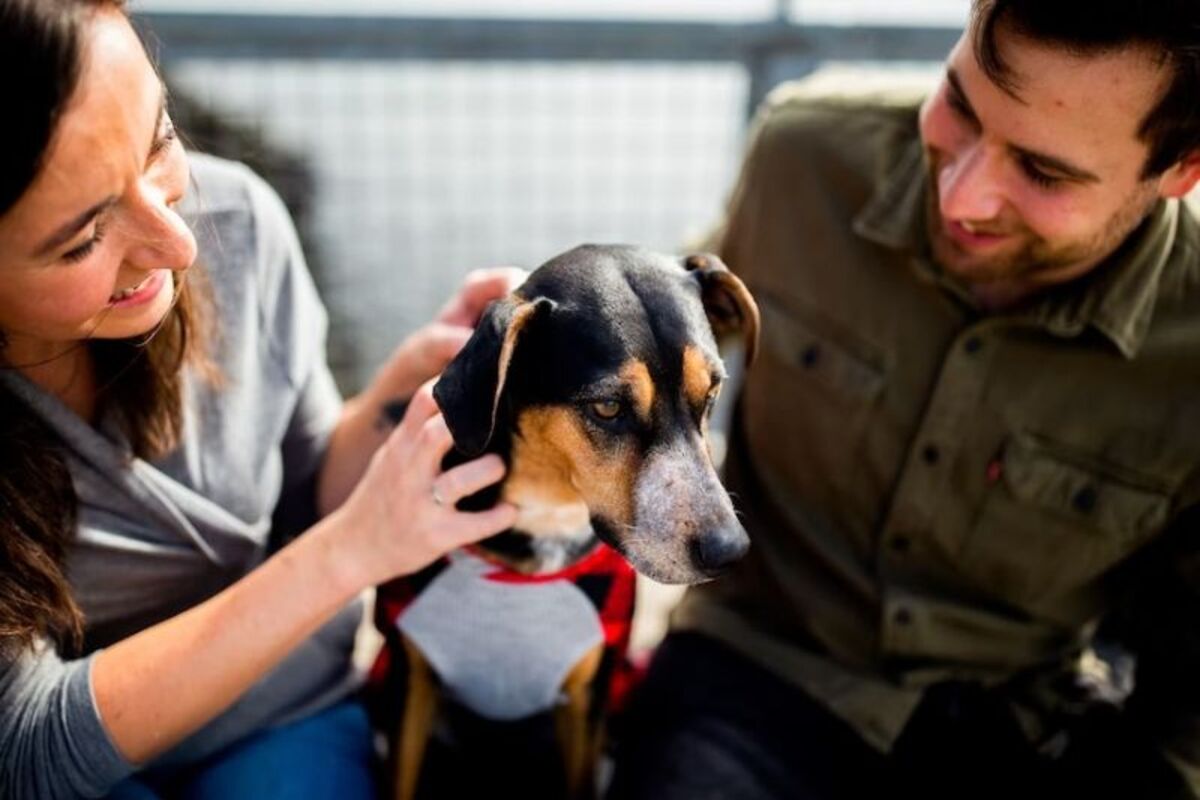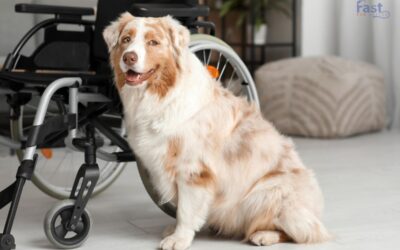How to Train a Psychiatric Service Dog (PSD)?

What is a Psychiatric Service Dog (PSD) and What Tasks Do They Perform for Individuals?
1. Emotional Support and Grounding Techniques
- PSDs are trained to sense anxiety or panic and perform grounding actions like nudging, sitting close, or pawing.
- Grounding helps individuals stay present and reduce overwhelming feelings.
2. Interrupting Harmful Behavior
- Some PSDs are trained to intervene in harmful behaviors like self-harm, pacing, or compulsive actions.
- For example, they might nudge or gently lick their handler to refocus attention.
3. Medication and Routine Reminders
- Many individuals with mental health challenges struggle with routine.
- PSDs can be trained to remind their handlers to take medications, attend therapy sessions, or engage in daily self-care tasks.
4. Providing Comfort During Panic Attacks or Nightmares
- PSDs offer comfort by lying beside their handler or resting their head on their handler’s lap during intense moments.
- For individuals with PTSD, they may gently wake their handler from nightmares.
5. Public Safety and Social Buffering
- PSDs are trained to keep their handlers safe in public, maintaining distance from crowds or finding exits during distressing moments.
- In social situations, PSDs can create a buffer that helps their handler feel safer and more comfortable.
How to Train a Psychiatric Service Dog?
1. Self-Training a Psychiatric Service Dog
Self-training allows you to form a unique bond with your psychiatric service dog (PSD) and tailor training directly to your specific mental health needs. It can be a rewarding experience and may also reduce the cost associated with hiring a professional.
Developing a Training Plan
- Start by creating a list of essential tasks and obedience commands. Determine which tasks, such as deep pressure therapy or anxiety alerts, will benefit you the most.
- Break down each task into small, manageable steps to make the learning process easier.
Patience and Consistency
- Training a PSD yourself requires considerable time, patience, and consistency.
- Daily practice and reinforcement help the dog learn commands and respond in various situations.
Challenges of Self-Training
- Training a PSD requires experience and understanding of dog behavior.
- Inexperience can lead to slower progress, so be prepared to adjust your approach as you learn.
2. Adopting a Trained Service Dog
If you’re seeking a PSD with established training, adopting a professionally trained dog can be a helpful option. This method is particularly useful for individuals who may lack the time or ability to train a PSD themselves.
Access to Expert Training
- Trained service dogs have completed comprehensive programs, ensuring they are well-prepared for their roles.
- Trainers assess dogs for specific tasks based on an individual’s needs, such as grounding techniques for panic attacks.
Preliminary Bonding and Adjustment Period
- Even with a trained PSD, a bonding and adaptation period is essential for the dog to adjust to your unique needs.
- This period helps establish a working relationship between you and the dog, which strengthens as you go through day-to-day experiences.
Drawbacks of adopting a trained PSD:
- Professionally trained PSDs can be expensive, often costing between $10,000 and $30,000 due to the extensive training process.
- Wait times may also be long, as there are limited numbers of trained PSDs available for adoption.
3. Using a Professional Dog Trainer
- Trainers specializing in PSDs bring expertise in teaching specific tasks and managing challenging behaviors.
- Trainers use positive reinforcement techniques to create a supportive and stress-free learning environment.
- Trainers can work with you to create a schedule that fits both your needs and your dog’s learning pace.
- Some trainers offer in-home services, while others may operate from dedicated training facilities.
- Trainers knowledgeable in PSD regulations help ensure the dog meets all legal standards and is equipped for public access.
- They also offer guidance on maintaining training to prevent skill regression.
Online vs. In-Person Psychiatric Service Dog Training Programs
| Feature | Online Training | In-Person Training |
|---|---|---|
| Convenience | Allows training from the comfort of home | May require travel to a training facility |
| Trainer Interaction | Limited to virtual meetings, email, or video | Direct, hands-on interaction with the trainer |
| Flexibility | Flexible schedules and self-paced modules | Fixed schedules with structured lessons |
| Cost | Often more affordable | Typically more expensive due to facility costs |
| Practical Skill Training | Requires at-home practice with online guidance | Hands-on skill training with immediate feedback |
| Socialization Opportunities | Limited to home and nearby locations | Exposure to various environments and distractions |
How Can You Teach Specific Skills to a PSD?
1. Deep Pressure Therapy (DPT)
2. Alerting to Anxiety or Panic Attacks
3. Medication Reminders
4. Interrupting Negative Behaviors
When Should You Seek Professional PSD Training Help?
1. Tasks are Complex or Specific
2. The Dog Displays Behavioral Issues
3. Public Access Requirements
4. Limited Time or Experience
What Are the Benefits of Training a PSD?
Training a psychiatric service dog comes with numerous benefits that significantly impact an individual’s mental and emotional well-being.
- Enhanced Mental Stability: PSDs provide consistent support that helps stabilize mood swings and anxiety. Their presence reduces the need for frequent interventions, allowing for a more independent lifestyle.
- Reduced Need for Medications: For some individuals, a PSD can lessen reliance on certain medications, as the dog provides a natural calming effect.
- Increased Social Confidence: Many handlers report greater social confidence due to their dog’s presence, which acts as a social bridge in interactions.
- Better Routine and Structure: PSDs help individuals maintain routines through reminders and structure, promoting long-term mental well-being.
- Emergency Assistance: PSDs trained to detect panic attacks, emotional overloads, or dissociation can provide immediate, on-the-spot intervention.
What to Consider While Training Your PSD?
Training a PSD takes time and consideration. Here are important factors to keep in mind:
- Consistency is Key: Use consistent commands and routines to avoid confusion and reinforce training. Regular practice ensures skills remain sharp.
- Positive Reinforcement Only: Avoid punishments, as they can harm the dog’s confidence and trust. Positive reinforcement methods create a safe and encouraging learning environment.
- Pace Yourself: Training can be overwhelming, so take it slow and give your dog time to master each skill.Training too quickly can lead to burnout and setbacks.
- Assess Training Needs Periodically: Regularly evaluate the dog’s training to make adjustments based on the handler’s evolving needs. This approach keeps the training relevant and effective.
What Should I Avoid When Training My Dog to Be a PSD?
Avoiding common mistakes can make training smoother and help develop a reliable psychiatric service dog.
- Do Not Use Punishment-Based Training: Negative reinforcement methods can damage the bond between dog and handler, reducing the dog’s effectiveness.
- Avoid Inconsistent Training: Inconsistent commands or sporadic training can confuse the dog and lead to setbacks.
- Avoid Neglecting Self-Care During Training: Training a PSD is time-intensive, but it’s essential for the handler to balance it with self-care to prevent burnout.
How Long Does It Take to Train a Dog to Be a PSD?
Training a psychiatric service dog takes considerable time, often spanning months to years.
- Basic Obedience Training: Generally takes 1-3 months.
- Task-Specific Training: Depending on complexity, task training can require 3-6 months.
- Public Access Training: This stage may take an additional 1-3 months for a fully reliable PSD.
- Ongoing Practice: Even after initial training, reinforcement is essential to maintain skills.
The timeline varies by dog, handler needs, and chosen training method.
How Much Does It Cost to Train a PSD?
The cost of training a psychiatric service dog varies widely, influenced by factors like location and trainer experience.
- DIY Training Costs: Costs may range from $500 to $2,000, covering supplies, books, and basic obedience classes.
- Professional Training Programs: Programs can range from $10,000 to $20,000 or more, depending on the level of support and duration.
- Additional Costs: Budget for ongoing expenses such as equipment, certification tests, and public access training.
Conclusion
Frequently Asked Questions
What Are The Training Requirements For A Psychiatric Service Dog?
What Are The Best Breeds For Training As Psychiatric Service Dogs?
Is Public Access Training Necessary For Psychiatric Service Dogs?
What Qualities Should A Dog Have To Become A Psychiatric Service Dog?
Is Professional Psychiatric Service Dog Training Necessary?
Are There Specific Training Programs For Service Dogs For Anxiety And Depression?
Yes, many programs focus on training PSDs for anxiety and depression support. These programs teach dogs to provide emotional grounding, interruption of negative behaviors, and comfort during anxiety or panic attacks, helping improve the handler’s quality of life.
Post Author
Prince Sharma
Related Articles
How To Get A Psychiatric Service Dog in Oregon?
How to Get a Psychiatric Service Dog in Oregon?To get a psychiatric service dog in Oregon, your dog must be trained to assist with your disability and help you manage day-to-day life activities. Additionally, you will need a PSD letter from a...
How to Get a Psychiatric Service Dog in Massachusetts?
How to Get a Psychiatric Service Dog in Massachusetts?To get a psychiatric service dog in Massachusetts, you need a recommendation from a licensed mental health professional and ensure the dog is trained to perform specific tasks related to your...
How To Get a Psychiatric Service Dog in Wisconsin?
How to Get a Psychiatric Service Dog in Wisconsin?To get a psychiatric service dog in Wisconsin, you need a diagnosis from a licensed mental health professional stating that a service dog would assist with your condition. Next, either train your dog...
Live and Fly Free with Your PSD!






